Renewable Energy Sources
- 2.1 Primary Renewable Energy Sources
- 2.2 Transformations of Primary Renewable Energy Sources
- 2.3 Summary
- Problems
As mentioned in Chapter 1, Introduction to Energy Systems, renewable energy systems (RESs) harness the energy that is being continuously supplied by the sun, transforming it into useful energy carriers to serve the needs of humankind.1 As an ultimate energy source, the sun is infinite and inexhaustible for all practical purposes; any fraction of primary energy converted to the energy carriers is continuously replenished, giving the energy system its renewable character.
Energy supplied by the sun is in the form of electromagnetic radiation, which can be converted directly into energy carriers—heat and electricity—in one of the configurations of the RESs. The solar radiation also sets in motion several natural processes that convert its intrinsic energy into other forms of energy. The end results of these processes include the creation of wind patterns, water cycle, biomass growth, and many others. Solar energy is converted into different forms of energy, such as mechanical energy and chemical energy, during these processes. Further conversion of these forms of energy is accomplished through other alternate configurations of RESs, yielding the energy carriers that drive the service technologies to satisfy the societal demand, as shown earlier in Figure 1.2. This chapter discusses the nature of primary energy sources (solar energy and other forms of energy arising from natural processes). An overview of the chemical separations and processes in the transformation of energy sources to carriers is also presented.
2.1 Primary Renewable Energy Sources
The well-known principle of the conservation of energy2 is a fundamental concept in physical sciences, which states that energy can neither be created nor destroyed, with only its form getting altered in any transformational process. The equivalence of all forms of energy is restricted to only the total content of all energy streams involved in the transformation, not to the nature or, more importantly, the utility of the energy streams involved in the transformation. The service technologies shown in Figure 1.2 typically require energy in the form of electricity, heat, or chemical energy, while the primary energy sources are rarely in these forms. The different energy sources can be classified in several different ways; however, at a fundamental level, they can be categorized into either potential energy—energy associated with the position of a body or its constituent bonds—or kinetic energy—energy associated with the motion. Potential energy is categorized into chemical energy, gravitational energy, nuclear energy, and mechanical energy, whereas kinetic energy includes radiant energy, thermal energy, motion, electricity, and so on [1]. Classical thermodynamics approaches the categorization of different energy types slightly differently, from macroscopic and microscopic perspectives. Macroscopic forms of energy are those forms that are defined with respect to an external reference frame, whereas the microscopic forms of energy are those that are based on molecular configuration of matter and microscopic, internal modes of motion [2]. Potential and kinetic energies in this classification are based on the location of a body in a potential field and the bulk motion of the body with respect to an external reference frame, respectively. These two forms of energy are referred to as the mechanical energy forms. Other forms of energy are based on motion and potential internal to the body, for example, molecular rotation and bonds, and are referred to as the internal energy forms. Chemical energy, under this classification, is a form of internal energy. This macroscopic/microscopic energy approach is used in discussing the various primary energy forms.
The most important primary renewable energy forms are solar energy, wind energy, hydropower energy, biomass energy, and geothermal energy. The first four of these energy forms are continuously replenished directly or indirectly by solar radiation. Geothermal energy arises out of the decay of radioactive isotopes in the earth. These radioisotopes are not being replenished continuously, and strictly speaking, geothermal energy lacks the renewability feature of these other energy forms. However, the geothermal energy reservoir is sufficiently large to satisfy energy demands for several million years according to some estimates, and for all practical purposes, infinite in nature [3]. The hydropower and wind energy forms can be categorized as mechanical energy forms, with hydropower energy having the characteristics of potential energy, and wind energy having the characteristics of kinetic energy. The other three forms are different manifestations of internal energy forms: chemical energy (biomass energy), radiant energy (solar energy), and thermal energy (geothermal energy). Figure 2.1 summarizes this categorization of the renewable energy sources. Each of these forms is discussed below in detail.
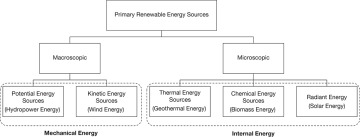
FIGURE 2.1 Categorization of primary renewable energy sources.
2.1.1 Solar Energy
The earth receives solar energy primarily in the form of electromagnetic radiation, which in itself is the product of nuclear fusion reactions, primarily hydrogen fusion to helium, occurring in the sun [4]. The surface temperature of the sun is approximately 6000 K, and the sun emits electromagnetic radiation that is characteristic of a black body at this temperature. Figure 2.2 shows the solar irradiance, which is the power per unit area per unit wavelength as a function of the wavelength of the radiation.
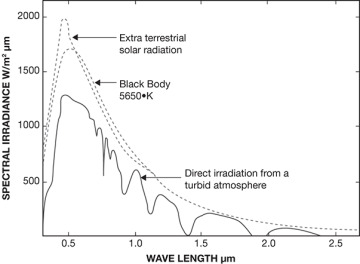
FIGURE 2.2 Solar spectral irradiance.
Source: Sen, Z., “Solar Energy in Progress and Future Research Trends,” Progress in Energy and Combustion Science, Vol. 30, 2004, pp. 367–416.
As can be seen from the curve, the peak irradiance occurs approximately at a wavelength of 0.5 μm. The area under the irradiance curve between any two wavelengths is equal to the power radiated per unit area by the sun by the electromagnetic radiation between those two wavelengths. The total area under the curve is the total solar irradiance, that is, the radiation flux from the sun. The value of the total solar irradiance at the top of the earth’s atmosphere, also called the solar constant, is ~1360 W/m2 [5]. This incident solar radiation interacts with the constituents of the earth’s atmosphere with fractions of it getting absorbed in the atmosphere and reflected back into space, as well undergoing scattering before reaching the earth’s surface. The earth, in turn, also emits radiation back into space, albeit at a much higher wavelength.3 Overall, the incident solar energy is nearly balanced by the energy emitted by the earth, allowing a stable thermal equilibrium to exist that maintains temperature suitable for life [4]. Figure 2.3 depicts this energy balance for the radiant energy [6].
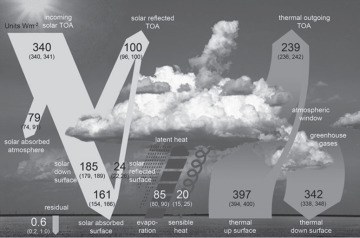
FIGURE 2.3 Radiation energy balance.4
Source: Wild, M., et al., “The Global Energy Balance from a Surface Perspective,” Climate Dynamics, Vol. 40, 2013, pp. 3107–3134.
The majority, nearly 55%, of the solar energy reaching the earth’s surface is in the infrared region, 40% of the energy is in the visible region, and 5% in the ultraviolet region [7]. The earth receives nearly 4 million EJ (~1.1 billion TWh) of solar energy every year, at a rate so large that the amount received in 1 hour exceeds the annual worldwide primary energy consumption [8].
2.1.2 Geothermal Energy
Geothermal energy, as can be inferred from the term, refers to the heat present in the interior of the earth, and is the result of radioactive decay of elements including the heat generated during the formation of earth (primordial heat), as well as ongoing decay of long-lived radioisotopes, such as 40K, 232Th, 235U, and 238U [9]. Figure 2.4 is a schematic of the earth’s interior, showing relative thicknesses of different parts of the earth including the crust, the mantle, and the inner and outer cores.
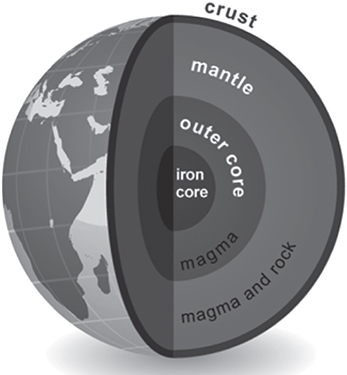
FIGURE 2.4 Earth’s interior structure.
Source: Adapted from a National Energy Education Development Project graphic (public domain). https://www.eia.gov/energyexplained/geothermal/.
The inner core of the earth, ~2400 km in diameter, is extremely hot, with a temperature approaching that of the surface of the sun (6000 K). The inner core is surrounded by a ~2400-km-thick outer core of hot molten rock—magma. A mantle layer consisting of ultrabasic and igneous rocks and a thickness of ~2900 km surrounds the outer core. The outermost layer is the crust, which has negligible thickness (<70 km) compared to the earth’s radius of approximately 6400 km [9, 10]. The temperature at the outer core mantle boundary is ~4200 K, while that in the upper mantle near the mantle crust boundary can be as low as 500 K. This radial variation in the temperature results in the establishment of significant temperature gradients within the earth’s interior, giving rise to both conductive and convective heat fluxes toward the earth’s surface. The average heat flux of earth is quite low (~80 mW/m2); however, the total available energy is significantly large. By some estimates, globally, the geothermal energy has the potential to generate 12,000 TWh of electricity annually, again exceeding the worldwide primary energy demand. If the geothermal energy is utilized directly without conversion to electricity, then the resource is even larger, at 600,000 EJ or ~170 million TWh per year [11].
Geothermal energy from the earth’s interior is transmitted to the surface through the mantle at various rates depending on the thermal conductivity of the geological formation and the temperature gradient, which is commonly taken as 30°C/km and may range from 10°C/km to 100°C/km [9, 11]. The interior of the earth is hardly uniform, though, and is characterized by widespread prevalence of geofluids—both aqueous and organic in nature, as well as in liquid and vapor states. These geothermal fluids also facilitate the transmission of the geothermal energy by convection. This heterogeneity leads to different configurations of geothermal energy sources [9, 11, 12]:
Hydrothermal—hot water or steam at moderate depths (100–4500 m)
Geopressed—hot water aquifers containing dissolved methane under high pressure at depths of 3–6 km
Hot dry rock—abnormally hot geologic formations with little or no water
Magma—molten rock at temperatures of 700°C–1200°C
Of the four types, the hydrothermal source is the only type that can be exploited economically with the prevalent technology. The hydrothermal sources are, as stated earlier, either liquid dominated (characterized by the presence of hot water) or vapor dominated (characterized by the presence of steam, i.e., water vapor). They can also be classified as high-temperature (>180°C), intermediate-temperature (100–180°C), and low-temperature (<100°C) systems. These resources can be harvested for electrical power generation, direct heat utilization, or combined heat and power applications [12].
The enormity of the total energy content of the earth in comparison to the primary energy demand makes geothermal energy practically inexhaustible, earning it its renewable characteristics. However, geothermal energy resources in the interior of earth are heterogeneous in the extreme, and geothermal energy fields are neither contiguous nor uniformly distributed across the earth. It is indeed possible to exhaust a geothermal energy reservoir, if energy is extracted out of it at a higher rate than the rate at which it is replenished by the processes occurring in the core. Proper reservoir management is indispensable for maintaining the presence of fluids in the hydrothermal fields and extraction at sustainable rates for ensuring long-term operation of the geothermal power plant [9].
2.1.3 Biomass Energy
Photosynthesis is the most fundamental process that plants perform to harness solar energy. It is the essential process without which no life will exist on earth. From the energy perspective, it can also be viewed as the process converting solar energy into chemical energy using carbon dioxide and water as the basic raw materials. This chemical energy is stored in the form of biomass and biochemical energy. Historically, as mentioned in Chapter 1, Introduction to Energy Systems, biomass has served as the energy source for all civilizations. Even today, populations in less developed countries continue to rely upon firewood as the primary energy source for cooking and heating applications [11].
Such traditional use of biomass through direct combustion is inefficient and unsustainable, contributes significantly to air pollution and carbon emissions, and affects human health adversely. Biomass-based RESs of the future are aimed at sustainable utilization of biomass through its conversion into chemicals that drive the modern, advanced service technologies. The biomass utilized for these conversions is cultivated and harvested specifically for energy applications. Different types of biomass serve as the energy source for these modern systems, the main ones being [11, 13]:
Agriculture and forest residues: examples of agricultural residues include corn stover, wheat straw, and rice straw; forest products and residues include hardwoods and softwoods grown in forests as well as the residue left after natural processes and harvesting of products.
Organic waste streams, including food and yard wastes, manure, and human sewage: examples of such streams include waste edible oils, residue from food processing plants, discarded leftover food, grass clippings from lawn, manure from large dairies and other animal farms, and municipal sewage.
Crops—either food crops used as fuel or energy crops grown specifically for use as fuel or conversion to chemicals: food crops such as sugar beets and sugarcane, corn and potato, soybean and sunflower, and so on can be easily converted into energy chemicals.5 Such diversion of food crops can cause significant disruption in the food supply chain and have disastrous consequences for a large fraction of global human population, and the future trend is to cultivate annual and perennial plant species such as switchgrass, miscanthus, bermudagrass, and microalgae.
Biomass is renewable and sustainable, and has the versatility to yield multiple energy carriers—electricity, heat, and chemicals, unlike the other renewable energy sources that are limited mostly to producing electricity. Geothermal and solar energy are exceptions in their ability to provide heat, but do not have the ability to yield chemicals. Biomass has theoretical potential to provide 30,000–80,000 TWh/year, with the low solar energy conversion efficiency (1%) of photosynthesis, and large area requirement limiting its growth [11].
2.1.4 Hydropower Energy
Solar energy is the driver for the water cycle consisting of evaporation, condensation, precipitation, and collection of water in bodies of water on earth, as shown in Figure 2.5.
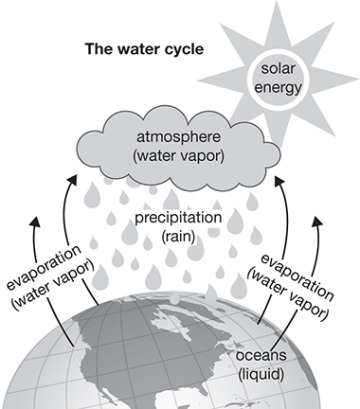
FIGURE 2.5 Water cycle on earth.
Source: Adapted from a National Energy Education Development Project graphic (public domain). https://www.eia.gov/energyexplained/hydropower/.
The flow of water under gravitational flow is harnessed to generate the electricity in the hydropower plants. Hydropower plants can be run-of-river (RoR) plants that utilize the natural flow of water in the river and channels. These plants are subject to significant seasonal and periodic variations depending upon the precipitation and runoff. The uncertainty associated with the RoR plants is avoided in the storage (reservoir) type of hydropower plants, where a dam is constructed to create large reservoirs to store water at an elevation—transforming the solar energy into potential energy in the gravitational force field [12]. The water is released to a lower elevation through turbines to generate electricity, as shown in Figure 2.6.
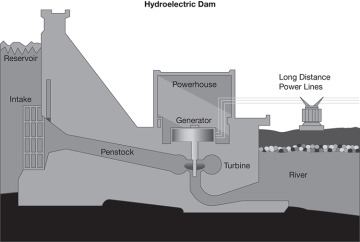
FIGURE 2.6 Reservoir hydropower plant.
Source: Tennessee Valley Authority (public domain). https://www.eia.gov/energyexplained/hydropower/.
Pumped storage hydropower plants are a special case of hydropower plants that utilize two reservoirs located at different elevations. These plants are not energy sources but energy storage devices associated with another power plant. Electricity generated by the power plant is used to pump water from the reservoir at the lower elevation to the one at the higher elevation at the times when the generation exceeds the consumer demand. The water stored in the upper reservoir is released through the turbines to augment the electricity generated in the main power plant when demand exceeds its capacity. Energy storage is described in greater detail in Chapter 6, Hybrid Energy Systems.
The inventory of water in the water cycle is estimated to be approximately 0.6 million km3. This volume is evaporated annually due to the solar energy incident on earth and is returned to it through precipitation. The amount precipitating on land is slightly less than 20% of this volume, at 112,000 km3. Slightly more than one-third of this volume ends up as runoff, with the balance getting absorbed by vegetation and land [11]. All of this volume, ~50,000 km3, in theory, can be harnessed to generate hydropower. The total theoretical potential for global hydropower generation, estimated from the runoff volumes and the altitudes at the corresponding locations, ranges from 44,000 to 128,000 TWh/year [11, 14]. Of course, technical limitation makes it impossible to exploit all of the precipitation runoff. Economic considerations further limit the exploitable resources, even when it is technically feasible to construct a hydropower plant. The economic potential for global hydropower production is considerably less than the theoretical potential at 8000–15,000 TWh/year [11, 14].
2.1.5 Wind Energy
Another effect of solar insolation is the heating of the earth’s surface. Earth’s surface being nonuniform, land and water coverage being the most elementary divisions, different regions heat up at different rates, leading to significant variations in temperatures across the globe. Tropical regions have a net gain of heat causing them to have higher temperature, while the polar regions are subject to a net loss and are considerably cooler [11]. This temperature difference, in turn, leads to density and pressure differences across locations, resulting in convective wind currents. Coastal regions experience daily wind cycles as air over the land heats up faster than that over the water, setting off winds from water to land, as shown in Figure 2.7 [15]. The wind direction is reversed in the night as the air mass cools down faster creating higher pressure over the land.
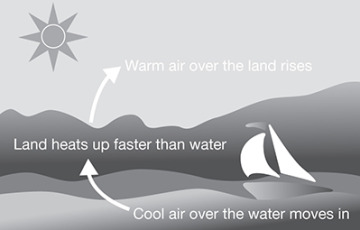
FIGURE 2.7 Daily wind cycle.
Source: Adapted from National Energy Education Development Project (public domain). https://www.eia.gov/energyexplained/wind/.
In addition to solar insolation, earth’s rotation contributes to establishment of circulatory patterns in the atmosphere. These patterns are further superimposed by local wind patterns arising out of local natural topographical features that lead to uneven heating. Anthropogenic structures may also interfere and influence these patterns [11].
Wind energy systems harness the kinetic energy of these circulatory patterns. Historically, wind energy was harnessed in direct applications such as sailboats for transportation and windmills for grinding flour or pumping water [16]. Wind power systems, wherein the kinetic energy of wind is first transferred to the kinetic energy of a wind turbine and then converted into electricity, are a relatively recent phenomenon [12]. Wind energy systems (henceforth referring to wind power systems, i.e., where electricity generation is taking place) have seen significant growth over the past two decades, with the global installed capacity approaching 500 GW [16]. These systems produced in excess of 1100 TWh of electricity in 2017 (https://www.eia.gov/energyexplained/wind/history-of-wind-power.php).
Although nearly every location on earth experiences wind patterns, practical technological constraints limit the exploitation of wind energy resources to those locations where the wind power density exceeds 400–500 W/m2. The global theoretical wind energy potential, on this basis, is approximately 500,000 TWh/year, exceeding the primary energy requirements. Advances in the wind energy technology can increase this potential even further. However, technical and economic limitations suggest that the actual realizable potential may be closer to 20,000 TWh annually [11].
In addition to the above five forms of energy sources that dominate the current renewable energy landscape, there exists another renewable energy source—marine energy—that can satisfy the primary energy demands for the foreseeable future and beyond. Marine (or ocean) energy actually consists of several different energy forms [11, 12, 17]:
Tidal current energy—kinetic energy of oceans arising from rotation of the earth in the gravitational field of the sun and the moon
Tidal barrage energy—potential energy exploiting the change in sea level during high and low tides by creating dams/barrages for the seawater
Wave energy—which captures the kinetic energy of the wind
Ocean thermal energy—based on the temperature differences between warmer surface waters and deep cooler waters
Salinity gradient energy—chemical energy based on the salinity differences between the freshwater that is discharged into oceans and the saline seawater
The theoretical potential of marine energy is in excess of 2 million TWh/year, with the ocean thermal energy exceeding the other types by at least two orders of magnitude [11]. However, all these technologies, except for tidal barrages, are in developmental stages. The current contribution of marine energy to renewable energy is negligible and not expected to rise significantly for the foreseeable future.
As can be gleaned from the above discussion, the renewable energy sources possess theoretical and technical potential to satisfy the entire primary energy demands of the global population. However, these primary sources need to be transformed into appropriate secondary energy sources—the energy currencies—in order to operate the service technologies. These transformations are discussed in the following section.